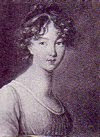
The Gunnister Man find is a fascinating archaelogical story and a precious gift to knitters. If anyone reading this is not familiar with it, there are numerous links on the internet. Piecework magazine also had an article by Deborah Pulliam, Gunnister Man’s Knitted Possessions in the September/October, 2002 issue.
This Gunnister Purse is knit according to the pattern* by Alison Milton from Midland Spinner’s Ravelry Downloads. The gauge is 10 stiches to the inch on 2.25mm/1US needles, in Morehouse Farm Merino Merino Lace, a single ply which resembles handspun. The tension/gauge of the original purse was 11 ½” stitches and 16 rows to the inch and my purse is 10 ½” stitches and 15 rows to the inch . The colours are Natural White, Natural Brown Heather and Henna, as close as I could find to the original purse’s ones. Knit in the round, I marked off the sections for the “intentional” errors in the ribbed top section, as stated in the pattern.
This finished purse measures 3 ¾” across and 5 ½” tall, just a tad off the measurements of the original purse which is 3 ¼” by 5 ¼”. The bottom edge was knit in a three needle cast/bind off. The cords are not of the same length, are braided/plaited with short tassels and are on a knitted chain of loops which are knitted from the top edge.

The Gunnister stocking is knit from Jacqueline Fee’s pattern, (Piecework, Volume XIX, Number 1, January/February, 2011), accompanying her article on reproducing the stockings in that issue, Re-Creating the Seventeenth Century Gunnister Stockings. I knit this one on 2.75mm needles for a gauge/tension of 7 ½ stitches and 10 rows to the inch, with almost three skeins of Brown Sheep Nature Spun Sport in Wood Moss. I love this colour; it is a dusky greenish brown. I followed Ms. Fee’s advice and added four more rows to the leg after completing the clock design but departed from her pattern by knitting an historical square heel and finishing with a drawstring toe instead of a grafted one. I also did all of the decreases in a right slant as I have seen on surviving period stockings. The stocking measures 26” long from the garter stitch welting to the bottom of the heel, 16” wide around at the top and at the calf and about 9 ½” around the ankle. The foot size is a Men’s 10/10 ½ /44.5.

The second stocking is well under way.
*This pattern for the purse also includes a detailed analysis of the purse and helpful comments about its construction updating the official report on the Gunnister find in The Proceedings of the Society of Antiquaries of Scotland of the National Museum of Antiquities, Edinburgh, Scotland, Volume 86 (1951-52)













